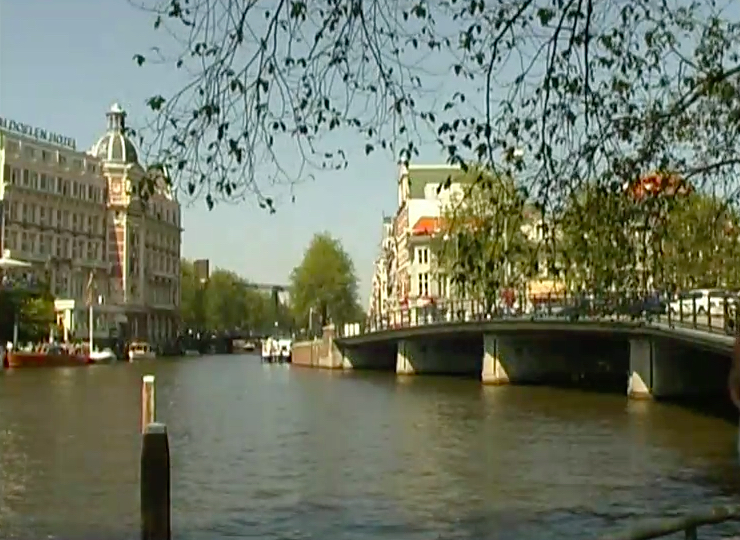Temporal View in Amsterdam
Temporal View in Amsterdam (After BB Turner), 2003.
A digital video projection commissioned by Huis Marseille Foundation for Photography, Amsterdam, with support from the University of Central Lancashire and Bow Arts Trust, London. Assistance: Cinzia Cremona.

Temporal View in Amsterdam (After BB Turner) 2003
This digital projection is based on a calotype image (Temporal View of the Halvemaansbrug and the Kloveniersburgwal) made by the English photographer Benjamin Brecknell Turner at the same location in 1857
The sole surviving version of this photograph is a paper negative (now in the collection of Gemeentearchief, Amsterdam ) made by Turner whilst on a photographic expedition to the Netherlands in the spring of 1857. This view, one of 16 calotypes Turner made that spring, is amongst the earliest photographs of the Amsterdam canals ever made.
This videograph was produced from digital video sequences recorded at the same location 146 years later. The images and sounds were recorded throughout a single day from 3:30 AM until 8PM, capturing the ordinary events and occurrences, the light changes and sounds that were framed within that view at those times. The moments presented can be seen as ‘typical’- the video is a kind of documentary of a particular time and place, a framing of the daily sounds and activities of and from a specific location.
In the video projections and installations I produced during 1999-2004 I was interested in the concept of “location” as both a place and a time. In works such as Merging/Emerging (1999), A Photographic Truth, 2001, For William Henry Fox Talbot (The Pencil of Nature) (2002) and Returning (2002-03) I extended this concept of location to include an historical dimension. In these works there is a crucial relationship to a specific place and time and this is established through the digital juxtapositioning of historical or documentary images that are associated with a particular time and place. In Temporal View in Amsterdam (After BB Turner) there is an important relationship between the original Turner image, its place in the canon of photographic history and a contemporary view from the exact location, with an awareness in the viewer of the spanning of the time between those two moments 146 years apart.
As there are no surviving prints from Turner’s negative, the digitally inverted image of the 1857 view provides an approximation of the printed photograph. Turner used the calotype process, producing a paper negative that was subsequently waxed to improve transparency for printing purposes. The process thus yields a positive and a negative image, the two opposites possessing a special symmetry. This relationship is important to the new work; the historical relationship between the original image and the contemporary one establishes an additional level of symmetry. After working with an earlier Turner photograph in a previous installation, (A Photographic Truth, 2001,) I discussed this notion of multiple symmetries with Martin Barnes, the curator of Photography at the Victoria and Albert Museum, London:
Martin Barnes: There are some moments where the image becomes negative, which for me makes a nice reference to the paper negative- the idea that calotype images are a marriage of two parts. There’s a paper negative that is a beautiful object in its own right, and is the same size as the final print. That also has a wonderful symmetry about it. It’s like squashing paint between two pages, and unfolding it to find the shape of a butterfly.
Chris Meigh-Andrews: It also has a symmetry in the mind, which is a parallel to the visual symmetry of the photograph. We are aware of the reality and it’s reflection, and then when we think of the negative (or see it) we become aware of the positive that is its reflection. The reflection of the negative is in the head. In my work I attempt to do things like that. I want the person looking at it to reflect on the process that is taking place – I don’t mean the technical process, but the process of perception. If we go back to ideas about the theory of montage- back to Eisenstein or Kuleshov, and think about all the different types of montage that they identified- all these experiences that can be evoked as a result of the juxtaposition of elements. I’m interested in something that might be called “conceptual montage”, wherein something on the screen is montaged with its opposite, or by it’s counterpart in the mind. One then becomes aware of the two simultaneously.
M.B: In a way that is almost a pure definition of the Romantic concept that Wordsworth has- an epiphany in “Tintern Abbey”, where he suddenly realises that the world constructed in his mind is half perceived and half generated, and its that that makes him alive.
C.M-A: Absolutely. I think that art should do that. Not all art, and not all the time- but there should be moments where that can happen. Being aware of one’s “aliveness” at the point of active engagement. Becoming aware of the ‘real’ and the interior- the exterior and the interior- and that’s the symmetry we have been talking about; a kind of symmetry of perception.